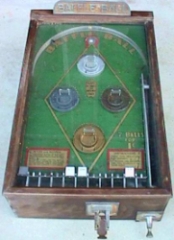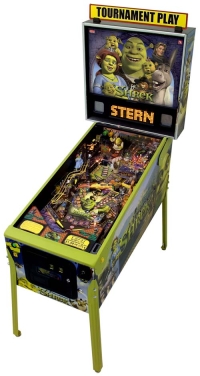
Now I am not really a huge pinball fan and I didn't play that many
pinball tables in the arcades as a youngster, or even since,
but the Pinball scene is huge. Pinball is essentially a coin-operated
arcade game where you score points by keeping the ball in play
and hitting different parts of the play field and maximizing
the time spent playing by earning extra balls and free games
known as replays.
Pinball is believed to have evolved originally from outdoor games like Bowls and Croquet which in turn gave rise to indoor games such as billiards around the 15th Century. Pinball tables however bear a striking resemblance to Bagatelle tables which themselves date back to 1777 when a party was thrown in honour of King Louis XVI and his wife at the Château de Bagatelle. The highlight of the party was a new table game where players used a cue to shoot ivory balls up an inclined play field. The table game was dubbed Bagatelle by the King's brother and soon swept through France before becoming popular in America when French Soldiers fighting the British in the American Revolutionary War took their tables with them. Bagatelle became so popular in America that a political cartoon from 1863 shows President Abraham Lincoln playing a tabletop bagatelle game.
In 1869 a British inventor named Montague Redgrave was granted US Patent #115,357 for his "Improvements in Bagatelle" which replaced the cue at the player's end of the table with a coiled spring and a plunger. The player shot balls up the inclined play field using this plunger, a device that remains in use on pinball tables to this day, and Redgrave's innovations in game design are acknowledged as the birth of pinball in its modern form.
Pinball is believed to have evolved originally from outdoor games like Bowls and Croquet which in turn gave rise to indoor games such as billiards around the 15th Century. Pinball tables however bear a striking resemblance to Bagatelle tables which themselves date back to 1777 when a party was thrown in honour of King Louis XVI and his wife at the Château de Bagatelle. The highlight of the party was a new table game where players used a cue to shoot ivory balls up an inclined play field. The table game was dubbed Bagatelle by the King's brother and soon swept through France before becoming popular in America when French Soldiers fighting the British in the American Revolutionary War took their tables with them. Bagatelle became so popular in America that a political cartoon from 1863 shows President Abraham Lincoln playing a tabletop bagatelle game.
In 1869 a British inventor named Montague Redgrave was granted US Patent #115,357 for his "Improvements in Bagatelle" which replaced the cue at the player's end of the table with a coiled spring and a plunger. The player shot balls up the inclined play field using this plunger, a device that remains in use on pinball tables to this day, and Redgrave's innovations in game design are acknowledged as the birth of pinball in its modern form.

In 1931 David Gottlieb's
Baffle Ball
became the first overnight
hit of the coin-operated era and it originally sold for
$17.50. The cost to play was a penny and that got you five
balls. The games could be found in many drugstores and
taverns and were so popular that the owner could often
make back the cost of the game in a matter of days. Baffle
Ball sold over 50,000 units and established Gottlieb as
the first major manufacturer of pinball machines. Soon
tables began to use electrical components to fire balls,
make sounds and illuminate the play table, and by the end
of 1932 there were approximately 150 companies manufacturing
pinball machines, most of them in Chicago, but competition
between rival companies was so fierce that by 1934 there
were only 14 companies left.
Chicago has been the centre of pinball manufacturing ever since and despite innovations in the game play such as speech, LEDs and computerisation the video game boom of the 1980s signaled the end of the boom for pinball. Arcade owners quickly replaced rows of pinball machines with games like Asteroids and Pac-Man which earned incredible amounts of money compared to the pinballs of the day, but Bally, Williams, and Gottlieb continued to quietly make pinballs while they also manufactured video games in much higher numbers.
After the collapse of the coin-operated video game industry pinball saw another comeback in the 1990s when some new manufacturers entered the fray such as Capcom Pinball. David Gottlieb's son, Alvin and Sam Stern's son, Gary both founded new pinball companies with great success and the digital era of pinball really took off with many TV and Movie licensed games such as Indiana Jones, Star Trek and the record selling Bally/Williams game The Addams Family hitting an all-time modern sales record of 20,270 machines.
By 1997 there were only two companies left, Williams and Sega Pinball, who later sold their pinball division to Gary Stern (President of Sega Pinball at the time) who called his new company Stern Pinball. Stern Pinball is the only current manufacturer of pinball machines, and they are unique in that they will re-run popular tables instead of just making one limited production run. This enables arcade operators and home enthusiasts to obtain classic Stern machines in brand new condition.
So what about playing Pinball in a virtual environment then? Well, most early simulations were top-down 2D games such as the 1982 game David's Midnight Magic for the Apple II, Commodore 64, and Atari computers which was notable for being the first commercial simulation of an existing pinball machine, namely Williams' Black Knight.
Over time, and with improving computer specifications, more accurate ball physics and 3D simulations have become possible and while most pinball simulators feature tables created specifically for the computer there are now commercially available packages featuring renditions of simulated Gottlieb tables for the PC, PlayStation 2, Xbox, PSP and Nintendo Wii.
Chicago has been the centre of pinball manufacturing ever since and despite innovations in the game play such as speech, LEDs and computerisation the video game boom of the 1980s signaled the end of the boom for pinball. Arcade owners quickly replaced rows of pinball machines with games like Asteroids and Pac-Man which earned incredible amounts of money compared to the pinballs of the day, but Bally, Williams, and Gottlieb continued to quietly make pinballs while they also manufactured video games in much higher numbers.
After the collapse of the coin-operated video game industry pinball saw another comeback in the 1990s when some new manufacturers entered the fray such as Capcom Pinball. David Gottlieb's son, Alvin and Sam Stern's son, Gary both founded new pinball companies with great success and the digital era of pinball really took off with many TV and Movie licensed games such as Indiana Jones, Star Trek and the record selling Bally/Williams game The Addams Family hitting an all-time modern sales record of 20,270 machines.
By 1997 there were only two companies left, Williams and Sega Pinball, who later sold their pinball division to Gary Stern (President of Sega Pinball at the time) who called his new company Stern Pinball. Stern Pinball is the only current manufacturer of pinball machines, and they are unique in that they will re-run popular tables instead of just making one limited production run. This enables arcade operators and home enthusiasts to obtain classic Stern machines in brand new condition.
So what about playing Pinball in a virtual environment then? Well, most early simulations were top-down 2D games such as the 1982 game David's Midnight Magic for the Apple II, Commodore 64, and Atari computers which was notable for being the first commercial simulation of an existing pinball machine, namely Williams' Black Knight.
Over time, and with improving computer specifications, more accurate ball physics and 3D simulations have become possible and while most pinball simulators feature tables created specifically for the computer there are now commercially available packages featuring renditions of simulated Gottlieb tables for the PC, PlayStation 2, Xbox, PSP and Nintendo Wii.

Visual Pinball, released by Randy Davis in 2001, is a simulation
and editor program that allows users to create and play 3D computer
simulations of pinball machines on a personal computer. More
importantly its ability to import external sounds and images
allows players to recreate and play renditions of real pinball machines.
Every Visual Pinball table comprises two main parts: the "physical" play field design (displayed in the editor) and the script which controls the table game play. The editor uses Visual Basic but the Visual Pinball program itself is written in C++ with ATL (which helps in making ActiveX controls) thus allowing Visual Pinball to run on Windows 98 or newer.
Visual PinMAME is an ongoing project that is similar to M.A.M.E. in that it combines the Visual Pinball program with an emulator that recreates the hardware CPUs and the connected ROM chips used in modern pinball tables. Unlike older tables with solid-state electronics and electro-mechanical devices that contain no ROMs or advanced chips in their hardware design, most modern tables require VPinMAME to run as it controls both the behavior of the simulation in Visual Pinball and reproduces the sounds and score displays of the actual tables. Without VPinMAME, Visual Pinball can be used to make original pinball and pinball-like games such as pitch-and-bat baseball, pinball bingo, and pachinko.
Well it all sounds very complicated but come on, we're on installment three here. Nobody has got this far through these incoherent, and at times over indulgent, ramblings without being up for a challenge, so how do we set it up on Windows XP?
Every Visual Pinball table comprises two main parts: the "physical" play field design (displayed in the editor) and the script which controls the table game play. The editor uses Visual Basic but the Visual Pinball program itself is written in C++ with ATL (which helps in making ActiveX controls) thus allowing Visual Pinball to run on Windows 98 or newer.
Visual PinMAME is an ongoing project that is similar to M.A.M.E. in that it combines the Visual Pinball program with an emulator that recreates the hardware CPUs and the connected ROM chips used in modern pinball tables. Unlike older tables with solid-state electronics and electro-mechanical devices that contain no ROMs or advanced chips in their hardware design, most modern tables require VPinMAME to run as it controls both the behavior of the simulation in Visual Pinball and reproduces the sounds and score displays of the actual tables. Without VPinMAME, Visual Pinball can be used to make original pinball and pinball-like games such as pitch-and-bat baseball, pinball bingo, and pachinko.
Well it all sounds very complicated but come on, we're on installment three here. Nobody has got this far through these incoherent, and at times over indulgent, ramblings without being up for a challenge, so how do we set it up on Windows XP?
Copyright © JamesOnline.net. All rights reserved.